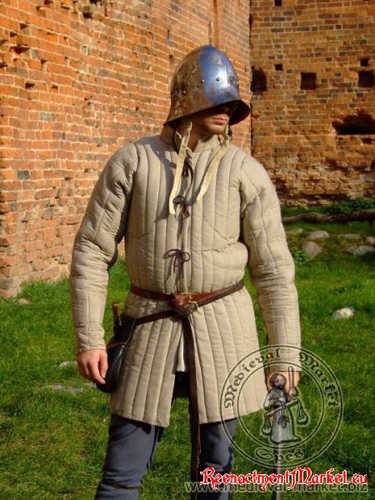
Gambeson type 6 - Machine sewing
| Type of product: | gambeson |
| Dating of product : | Century: XIV, XV |
| Nation: | knigts |
| Historical source: |
iconography |
| Material: | linen |
| Technology of manufacturing: | machine sewing |
| Product Status: | order |
| Delivery Time: | 40 days |
Thickness:
Average; 2 layers of wadding on body, 1 layer on arms (with streghtening on elbows and shoulders)
Gambesons were a cheap protection for the fighting men in the Middle Ages, but only the poorest ones used only them as their single armour. For others they were a part of a complete protective armament, providing amortization of the hit and the protection of attritions from the armour. Among padded protective elements we can find: gambesons protecting the trunk and hands, padded gloves, padded coifs and separate hoses. They were sewn from layers of a fabric. In the 13th century gambesons were long and rather badly-fitted to the figure. They were usually put over the head and buttoned only near the neck. Later, with the development of other elements of the armour, gambesons were shorter and better fitted to the body. In the 14th and the 15th centuries they were usually buttoned at the front or laced up.
Gambeson stuffing/layering
Normally we use:
- linen first layer
- second strengthening layer (cotton)
- few layers of batting(for specific numbers, see description of the chosen quilted garment)
- linen lining
In all arming garments (quilted hood etc.), you can change the padding - for thick wollen fabric(+10EUR). It can be also changed for felted sheep fleece (+25 EUR). In case of high standard, woolen fabric is used for amortisation layers instead of batting fabric.

